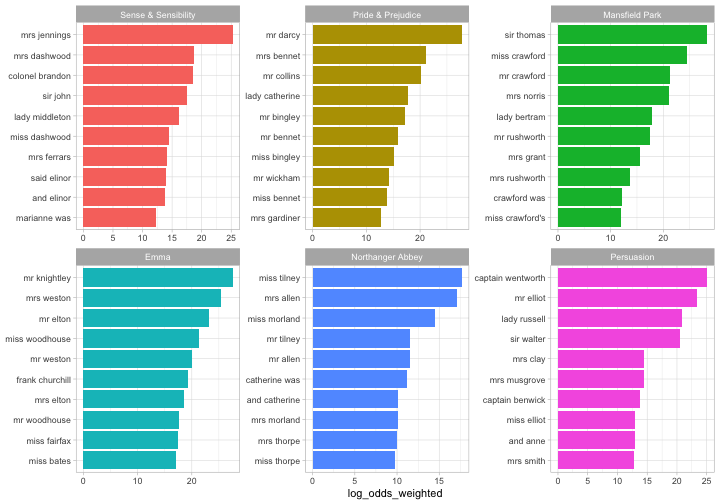juliasilge / Tidylo
Programming Languages
Labels
Projects that are alternatives of or similar to Tidylo
tidylo: Weighted Tidy Log Odds Ratio
Authors: Julia Silge, Alex Hayes, Tyler Schnoebelen
License: MIT
How can we measure how the usage or frequency of some feature, such as words, differs across some group or set, such as documents? One option is to use the log odds ratio, but the log odds ratio alone does not account for sampling variability; we haven't counted every feature the same number of times so how do we know which differences are meaningful?
Enter the weighted log odds, which tidylo provides an implementation for, using tidy data principles. In particular, here we use the method outlined in Monroe, Colaresi, and Quinn (2008) to weight the log odds ratio by a prior. By default, the prior is estimated from the data itself, an empirical Bayes approach, but an uninformative prior is also available.
Installation
You can install the released version of tidylo from CRAN with:
install.packages("tidylo")
Or you can install the development version from GitHub with remotes:
library(remotes)
install_github("juliasilge/tidylo", ref = "main")
Example
Using weighted log odds is a great approach for text analysis when we want to measure how word usage differs across a set of documents. Let's explore the six published, completed novels of Jane Austen and use the tidytext package to count up the bigrams (sequences of two adjacent words) in each novel. This weighted log odds approach would work equally well for single words.
library(dplyr)
#>
#> Attaching package: 'dplyr'
#> The following objects are masked from 'package:stats':
#>
#> filter, lag
#> The following objects are masked from 'package:base':
#>
#> intersect, setdiff, setequal, union
library(janeaustenr)
library(tidytext)
tidy_bigrams <- austen_books() %>%
unnest_tokens(bigram, text, token = "ngrams", n = 2)
bigram_counts <- tidy_bigrams %>%
count(book, bigram, sort = TRUE)
bigram_counts
#> # A tibble: 328,495 x 3
#> book bigram n
#> <fct> <chr> <int>
#> 1 Mansfield Park of the 748
#> 2 Mansfield Park to be 643
#> 3 Emma to be 607
#> 4 Mansfield Park in the 578
#> 5 Emma of the 566
#> 6 Pride & Prejudice of the 464
#> 7 Emma it was 448
#> 8 Emma in the 446
#> 9 Pride & Prejudice to be 443
#> 10 Sense & Sensibility to be 436
#> # … with 328,485 more rows
Now let's use the bind_log_odds() function from the tidylo package to find the weighted log odds for each bigram. The weighted log odds computed by this function are also z-scores for the log odds; this quantity is useful for comparing frequencies across categories or sets but its relationship to an odds ratio is not straightforward after the weighting.
What are the bigrams with the highest weighted log odds for these books?
library(tidylo)
bigram_log_odds <- bigram_counts %>%
bind_log_odds(book, bigram, n)
bigram_log_odds %>%
arrange(-log_odds_weighted)
#> # A tibble: 328,495 x 4
#> book bigram n log_odds_weighted
#> <fct> <chr> <int> <dbl>
#> 1 Mansfield Park sir thomas 287 28.3
#> 2 Pride & Prejudice mr darcy 243 27.7
#> 3 Emma mr knightley 269 27.5
#> 4 Emma mrs weston 229 25.4
#> 5 Sense & Sensibility mrs jennings 199 25.2
#> 6 Persuasion captain wentworth 170 25.1
#> 7 Mansfield Park miss crawford 215 24.5
#> 8 Persuasion mr elliot 147 23.3
#> 9 Emma mr elton 190 23.1
#> 10 Emma miss woodhouse 162 21.3
#> # … with 328,485 more rows
The bigrams more likely to come from each book, compared to the others, involve proper nouns. We can make a visualization as well.
library(ggplot2)
bigram_log_odds %>%
group_by(book) %>%
top_n(10) %>%
ungroup %>%
mutate(bigram = reorder(bigram, log_odds_weighted)) %>%
ggplot(aes(bigram, log_odds_weighted, fill = book)) +
geom_col(show.legend = FALSE) +
facet_wrap(~book, scales = "free") +
coord_flip() +
labs(x = NULL)
#> Selecting by log_odds_weighted

Community Guidelines
This project is released with a Contributor Code of Conduct. By contributing to this project, you agree to abide by its terms. Feedback, bug reports (and fixes!), and feature requests are welcome; file issues or seek support here.

